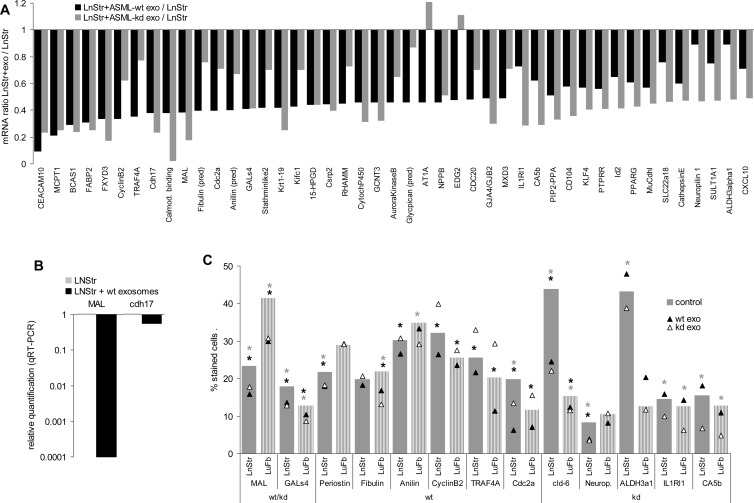Figure 6.
Reduced mRNA recovery and protein expression in LnStr and LuFb after co-culture with ASMLwt and ASML-CD44vkd exosomes: mRNA analysis was performed as described in Figure 5. (A) mRNA whose expression was reduced in LnStr by more than two-fold after co-culture with exosomes. (B) Confirmation of mRNA down-regulation (selected examples) by qRT-PCR (mean of three replicate samples with SD < 0.25, indicating reliability according to the software program for ΔCT) and (C) at the protein level in LnStr and LuFb by flow cytometry (mean percentage of stained cells, triplicates); examples are grouped according to reduced mRNA recovery after co-culture with ASMLwt and ASML-CD44vkd or ASMLwt or ASML-CD44vkd exosomes; significant differences between untreated LnStr/LuFb and LnStr/LuFb co-cultured with ASMLwt exosomes: black *; significant differences between untreated LnStr/LuFb and LnStr/LuFb co-cultured with ASML-CD44vkd exosomes: gray *. (B and C) Experiments were repeated three times revealing comparable results. mRNA microarray analysis confirmed the strong impact of exosomes on mRNA recovery in target cells. Many effects were observed with ASMLwt and ASML-CD44vkd exosomes, but distinct regulations, e.g., of cyclin B2, TRAF4, IL1RI1, and Id2 by ASMLwt and ASML-CD44vkd exosomes were also observed. Abbreviations: CEACAM10, CEA-related cell adhesion molecule 10; MCPT1, mast cell protease; BCAS1, breast carcinoma amplified sequence; FABP2, fatty acid binding protein 2; FXYD3, FXYD domain-containing ion transporter regulator 3; TRAF4, TNF receptor-associated factor 4; cdh17, cadherin-17; MAL, myelin and lymphocyte protein; Cdc2a, cell division cycle 2 homolog A; GALs4, galactose binding soluble 4 lectin; Krt1-19, keratin complex 1, acidic, gene 19; Kifc1, kinesin family member C1; 15-HPGD, 15-hydroxyprostaglandin dehydrogenase; Csrp2, cysteine and glycine-rich protein 2; GCNT3, glucosaminyl (N-acetyl) transferase 3; AT1A, angiotensin II receptor 1; NPPb, natriuretic peptide precursor type B; EDG2, endothelial differentiation, lysophosphatidic acid G protein-coupled receptor 2; CDC20, cell division cycle 20 homolog; GJA4/GJB2, GAP junction membrane channel; MXD3, Max dimerization protein; IL1Rl1, interleukin-1 receptor-like 1; CA5b, carbonic anhydrase VB; CD104, integrin β4; KLF4, Kruppel-like factor 4; PTPRR, protein tyrosine phosphatase, receptor type; Id2, inhibitor of DNA binding 2; PPARG, peroxisome proliferator-activated receptor gamma; MuCdhl, mucin and cadherin like; SLC22a18, tumor-suppressing subtransferable candidate 5; SULT1A1, sulfotransferase family 1A; ALDH3α1, aldehyde dehydrogenase family 3, member A1.

